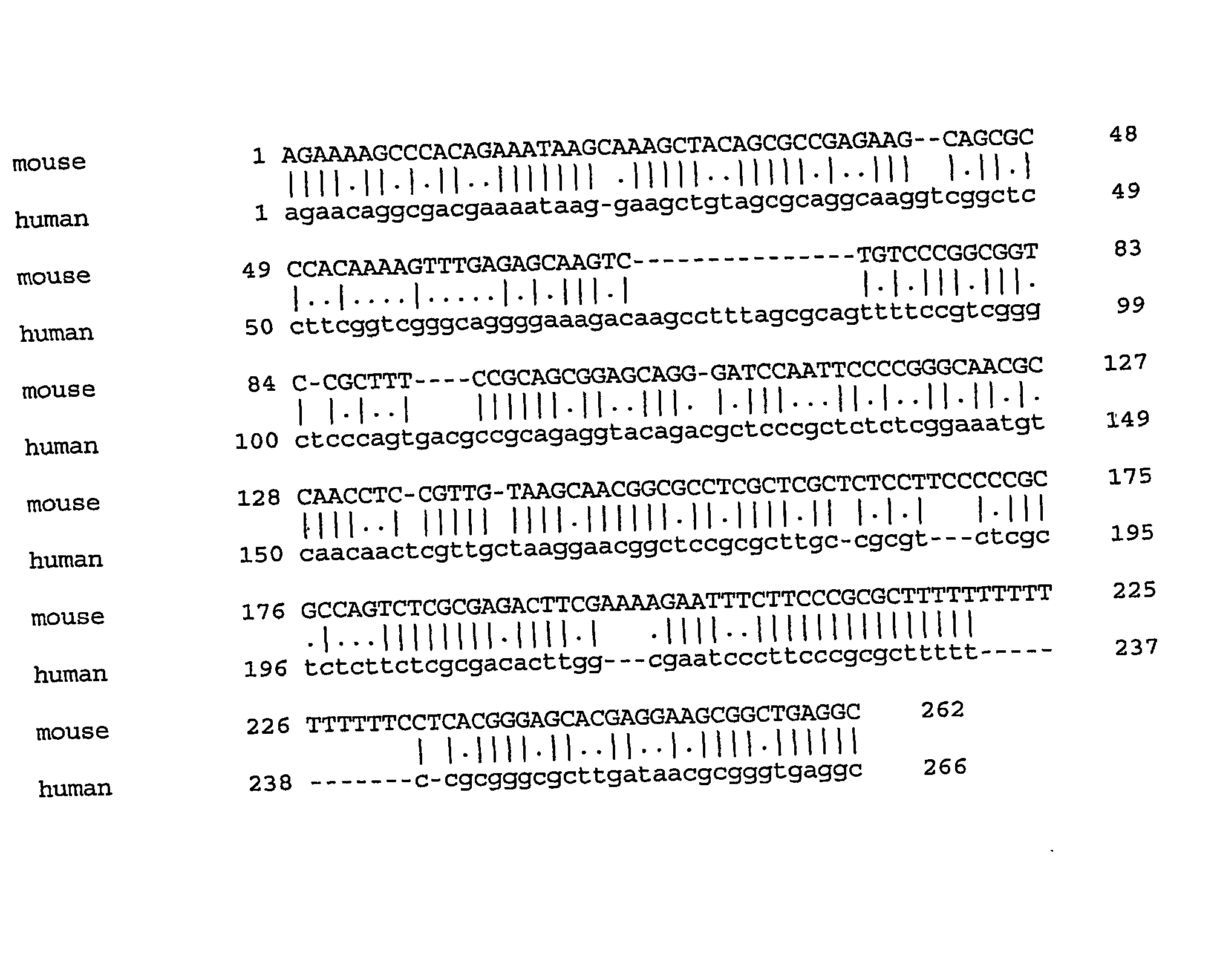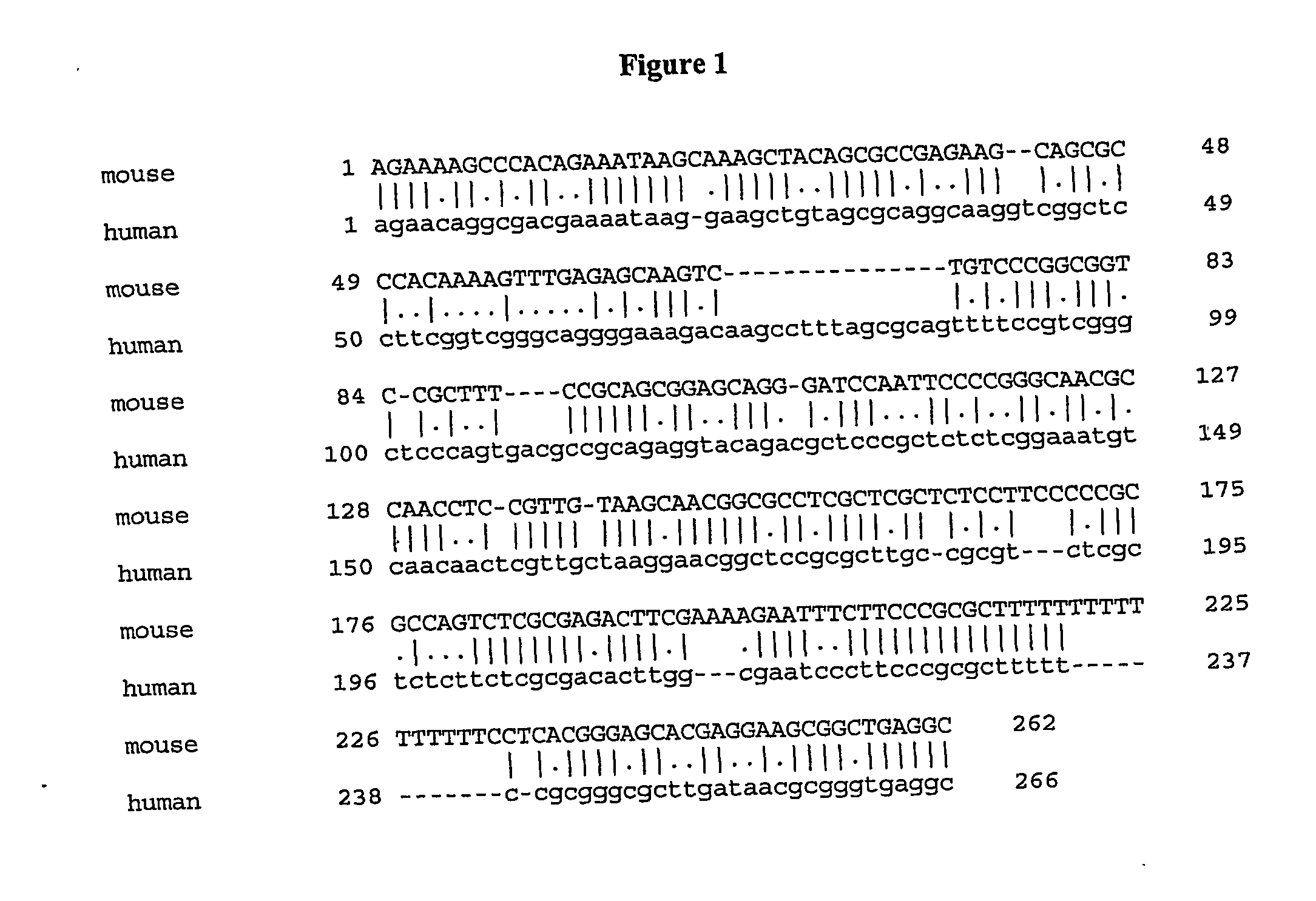Methods for Identifying Treatment and Inducing Infertility Using Smc1-Beta
a technology of smc1 and infertility, applied in the field of reproductive fertility, can solve the problems of affecting spermatogenesis and/or oogenesis, and the absence of smc1 is thought to have a deleterious
- Summary
- Abstract
- Description
- Claims
- Application Information
AI Technical Summary
Problems solved by technology
Method used
Image
Examples
example 1
Control of SMC1β Expression
[0237] To determine the transcription start site for the SMC1β gene, primer extension of mRNA is carried out as described by Ausubel et al. John Wiley and Sons, Inc. (2003). For fall characterization of the 5′ region of SMC1β, the start site for the gene (GenBank Accession No. AK016311 (SEQ ID NO: 7)) that originates somewhere around the first exon of SMC1β and is transcribed in reverse orientation is determined. For primer annealing, total RNA either from mouse testis or liver (control tissue which does not express SMC1β) is used. Both transcripts are relatively abundant as they can be easily detected by Northern blotting. Therefore, primer extension products are abundant enough to be detected directly in the denaturing polyacrylamide gel.
[0238] Information on the position of transcription start sites allow for selection of DNA fragments for electrophoretic mobility shift assay described below. If the transcription start sites of the two genes are far a...
example 2
Specific Protein Binding to the Promoter Region
[0241] To test specific binding of protein(s) to the promoter region, electrophoretic mobility shift assays (EMSA) are carried out with overlapping double-stranded synthetic oligonucleotides, approximately 30-35 bp long and spanning the region identified as a potential promoter by computer analysis. Oligonucleotides are designed to incorporate potential transcription factor binding sites detected by computer analysis. EMSA is performed according to published protocols (Akhmedov et al., J. Biol. Chem. 273:24088-24094, 1998; Akhmedov et al., J. Biol. Chem. 274:38216-38224, 1999). To identify factors specific for spermatogenesis, nuclear extracts, prepared either from mouse testis or liver, are used (Jessberger et al, Mol. Cell. Biol. 11:445-457, 1991; Jessberger et al., Journ. Biol. Chem. 26:15070-15079, 1993; Jessberger et al., Journ. Biol. Chem. 270:6788-6797, 1995; Jessberger et al., EMBO J. 15:4061-4068, 1996; Borggrefe et al., J. Bi...
example 3
[0245] Sequences within the SMC1β 5′ region that bind a testis-specific factor, as seen in EMSA and DNase footprinting assays, are used for purification of that binding activity from testis nuclear extracts. Standard DNA affinity chromatography, and an alternative method, oligonucleotide trapping (Gadgil et al., J. Chromatogr. A. 966:99-110, 2002), which is a modification of DNA affinity chromatography are used. For standard affinity chromatography, the double-stranded oligonucleotide is linked via an amino group coupled to one end to CNBr-sepharose beads. Nuclear extracts are loaded under conditions similar to the ones used in the EMSA experiments, and bound proteins are eluted with increasing salt concentration. In the alternative method, a column-attached single stranded oligonucleotide (AC)5 is used to trap from the solution a double-stranded footprint oligonucleotide with single stranded (TG)5 overhangs. First, the interaction between the binding pro...
PUM
| Property | Measurement | Unit |
|---|---|---|
| testis weights | aaaaa | aaaaa |
| testis weights | aaaaa | aaaaa |
| temperature | aaaaa | aaaaa |
Abstract
Description
Claims
Application Information
 Login to View More
Login to View More - R&D
- Intellectual Property
- Life Sciences
- Materials
- Tech Scout
- Unparalleled Data Quality
- Higher Quality Content
- 60% Fewer Hallucinations
Browse by: Latest US Patents, China's latest patents, Technical Efficacy Thesaurus, Application Domain, Technology Topic, Popular Technical Reports.
© 2025 PatSnap. All rights reserved.Legal|Privacy policy|Modern Slavery Act Transparency Statement|Sitemap|About US| Contact US: help@patsnap.com


